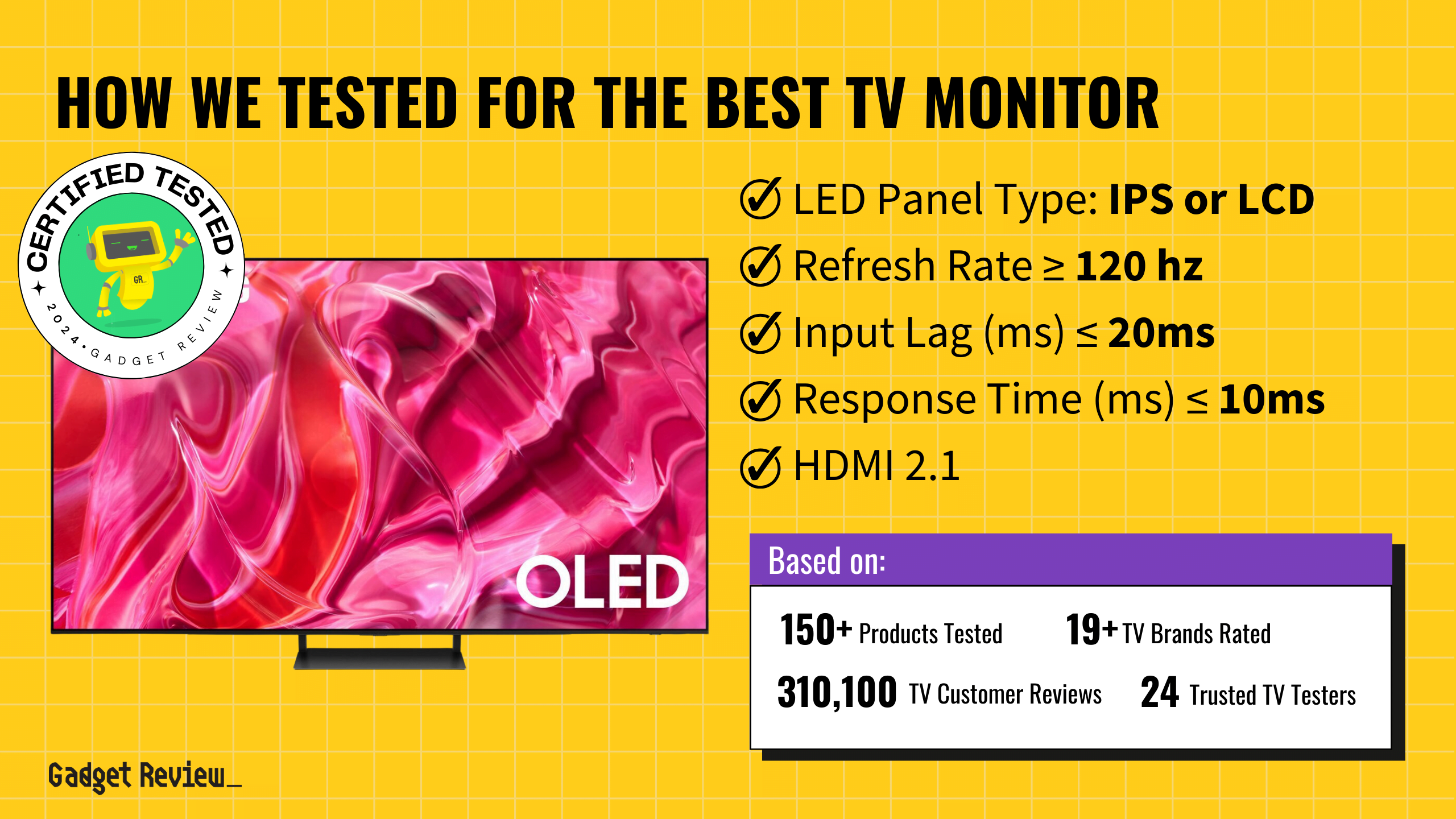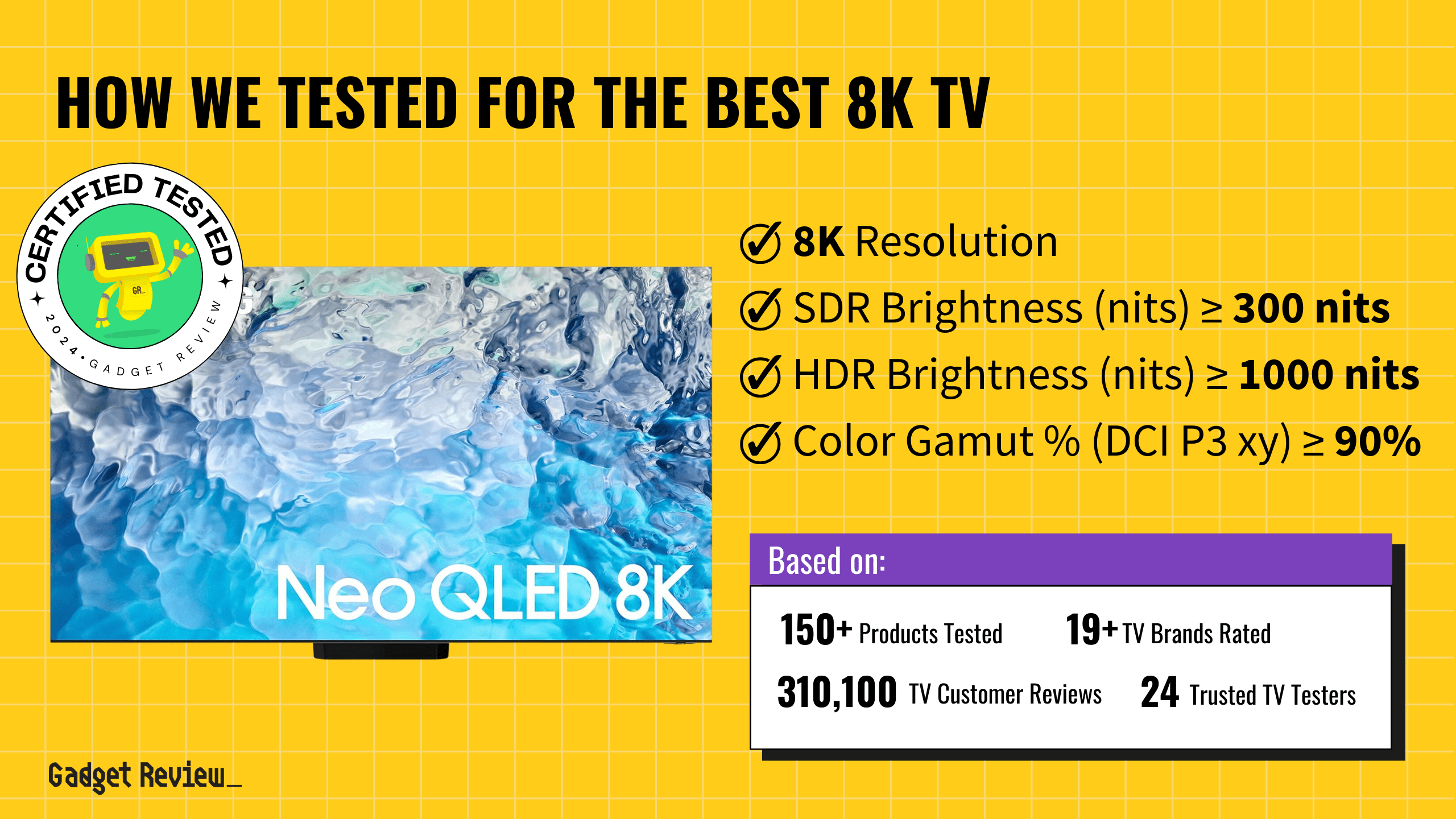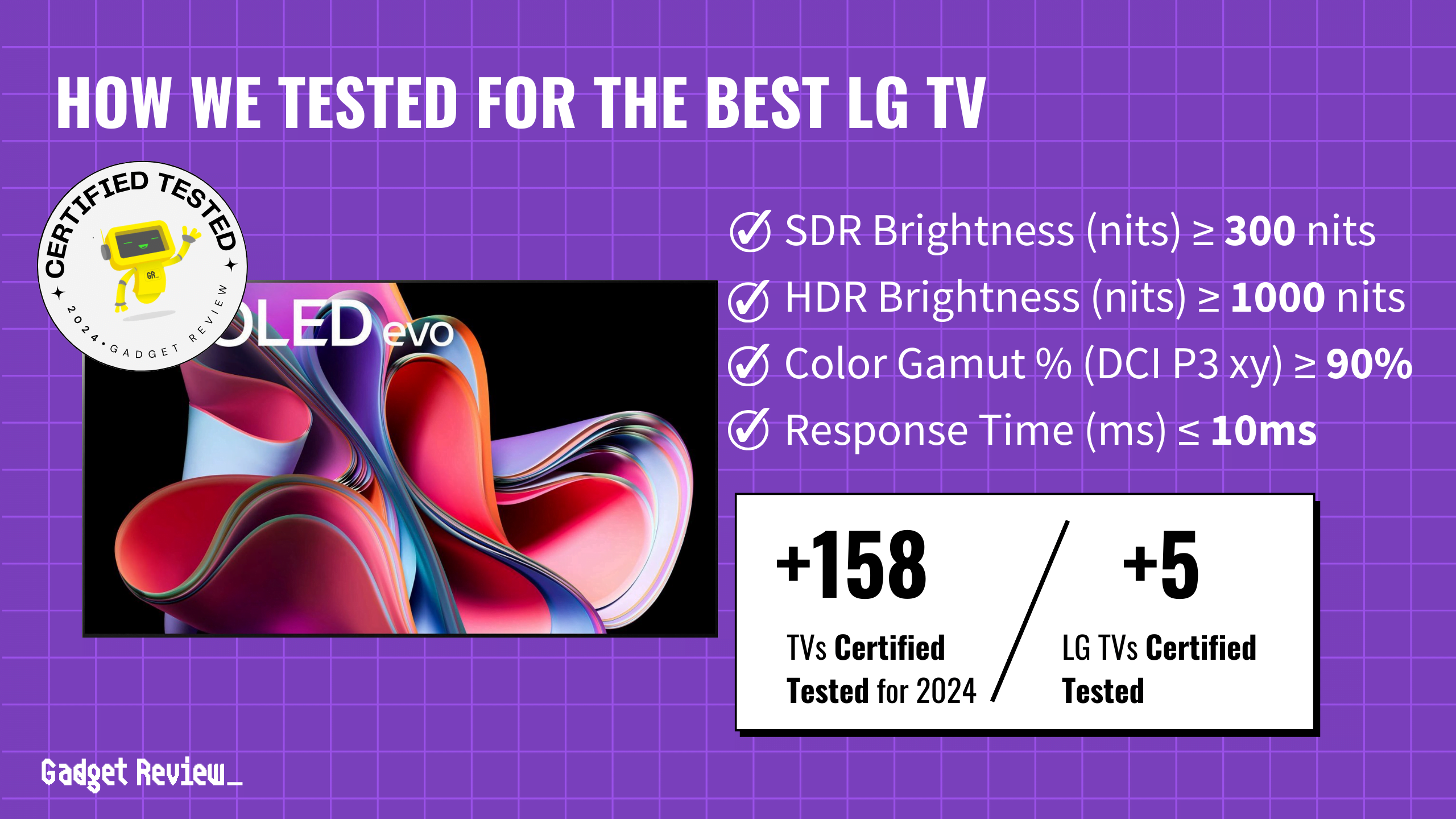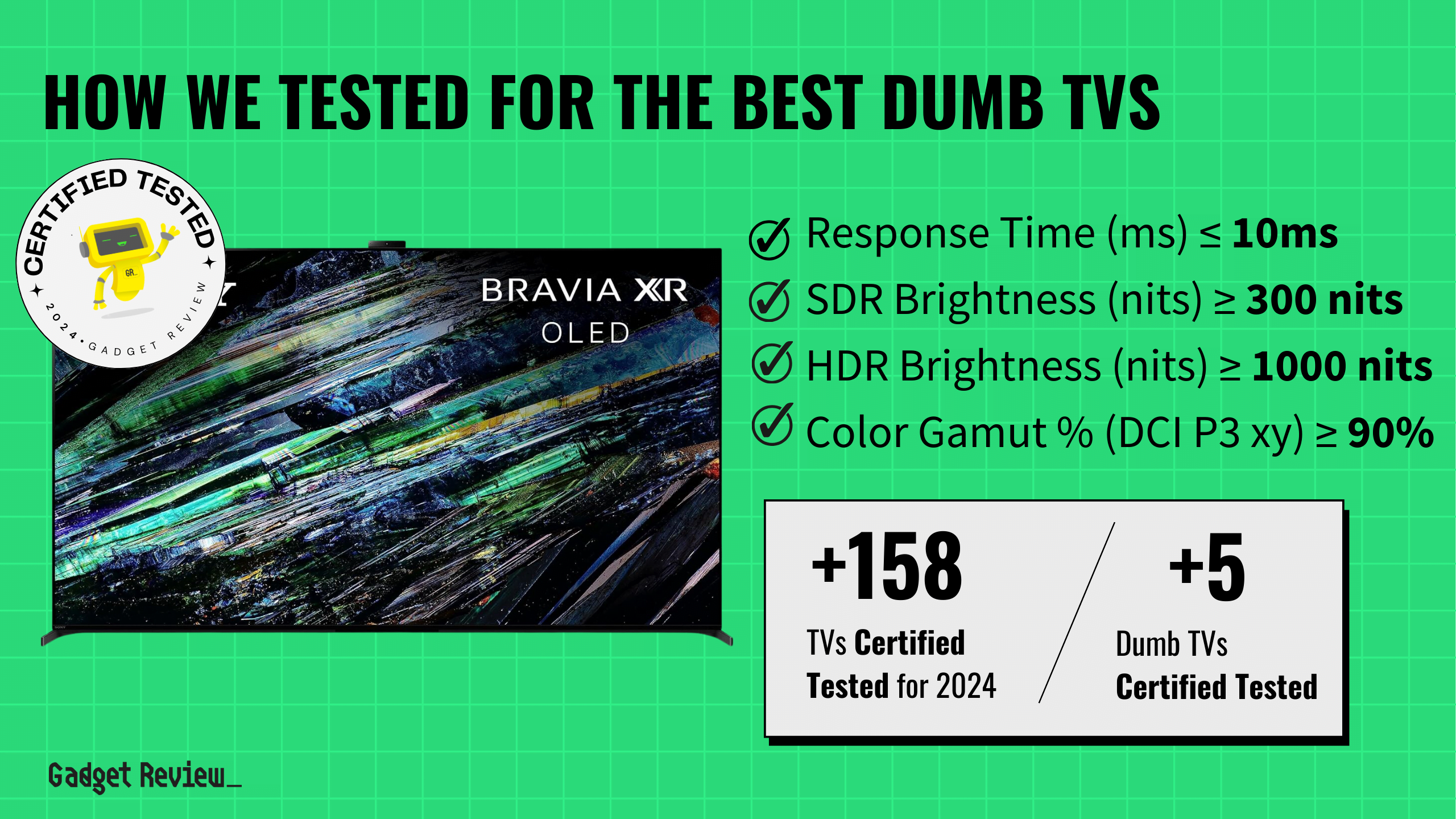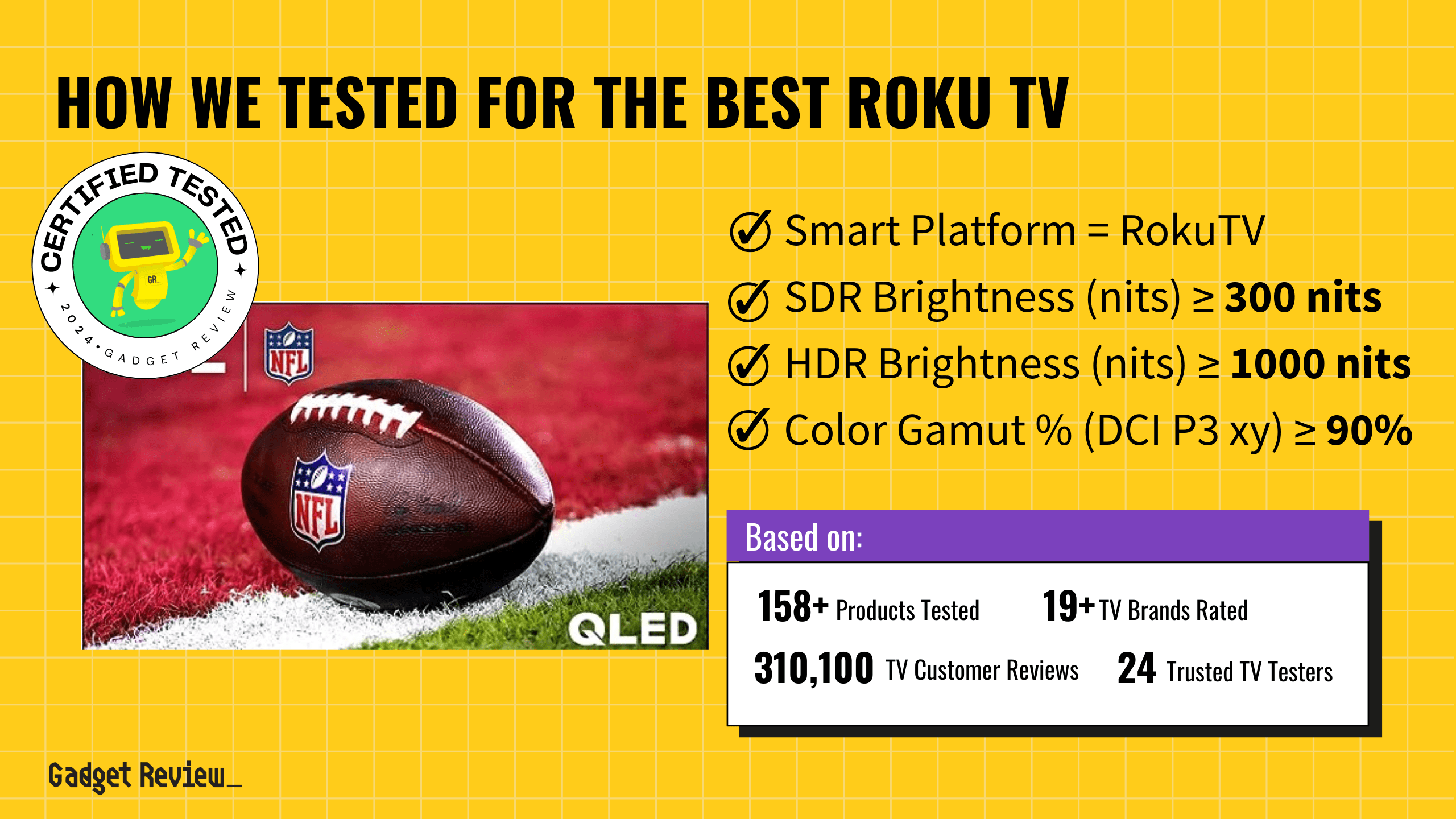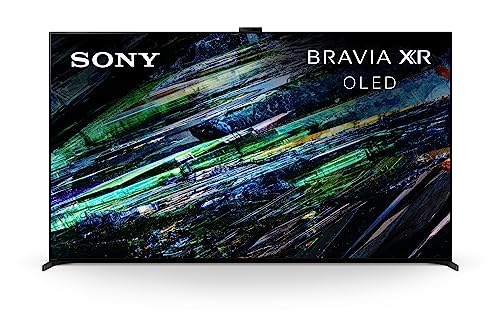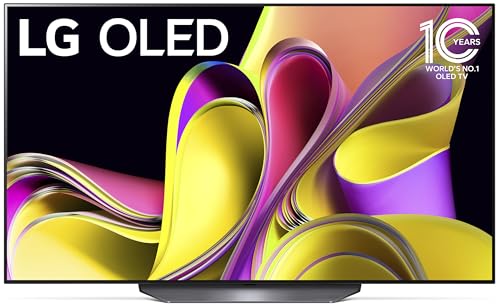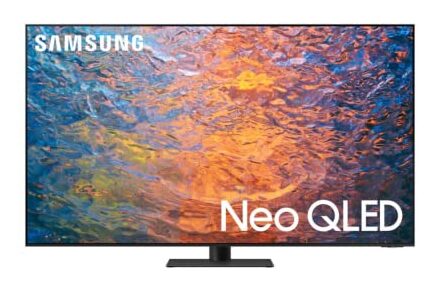Choosing the best TV monitor could mean the difference between a highly productive work session or a poor refresh rate for slow loading spreadsheets and web browsers. Our evaluation focused on performance/display, input lag, and refresh rate, in addition to a number of other metrics to determine the top-performing TVs.
How Did We Rank the Best TV Monitors?
To assess how high or low quality a TV actually is for TV Monitor, one must evaluate specific testing criteria against reference industry standards. Using our thorough TV Testing Methodology, we determined there are 2 minimum specs and 5 criteria below (2 required, 4 nice to have) that ensure your TV Monitor looks as good as the creator intended it.
?️ Minimum Specifications
- Resolution: 1080p to 4k
- Chroma: 4:4:4
? Test Criteria
- Input Lag: Less than or equal to 20ms.
- Response Time: Less than or equal to 10ms.
? “Nice To Haves”
- SDR Brightness: At least 300 nits for a bright, clear picture in any light.
- HDR Brightness: Exceeding 700 nits for immersive high dynamic range content with exceptional detail and contrast.
- Color Gamut: Minimum 97% DCI P3 color gamut for vibrant colors.
- Contrast Ratio: At least 10,000:1, for deep blacks and bright whites.
We’ve redefined TV buying guides, setting us apart from any other site on the planet. Our unique approach combines in-house verification with a comprehensive dataset from over 200+ trusted sites, focusing on key testing metrics to rank the top rated TV monitors. Testing data include brightness (300 nits SDR and 700 nits HDR), Color Gamut % (DCI P3 xy) >= 97%, and a set that has Max Resolution: 1080p to 4k. In this case it’s for TV monitors, which means overcoming bright lights and fitting in a tight space. Discover our data-driven methodology for precise, reliable TV monitor recommendations. Our commitment to unbiased reviews is powered by our ‘True Score’ system, targeting low quality and fake reviews. Commissions fund this mission. No bias. No BS.
Latest Updates
- 03/01/2024: Completely and thoroughly overhauled the guide to include the best and latest TV Monitors.
- 11/29/2023: Republished the list to include TVs based on our True Score system.
Top Best TV Monitors For 2025
Prices accurate at the time of publishing
For our list, TV monitors must be 1080p to 4K, glare-resistant and offer Chroma 4:4:4. If it doesn’t meet these criteria, it’s not on our list!

Best Overall

Runner Up

Best Value

Best Budget

Best Mid-Range

Premium Pick
Samsung S90C TV
Best For Home Theater
Unbeatable response time and phenomenal color accuracy makes the S90C ideal for gaming and color-critical work despite slightly lower brightness.
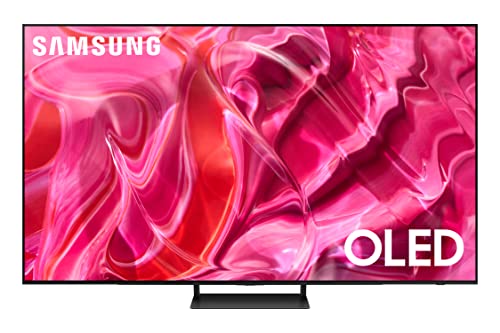
True Score
91938Experts
935kCustomers
Cosmic Wonder
 SAVE $511$1,499.99$989.00
SAVE $511$1,499.99$989.00Snapshot
Reasons to Buy
- Excellent picture quality
- The near-infinite contrast ratio for perfect blacks
- High peak brightness
- Exceptionally wide viewing angle
- Low input lag/Response time
- Sharp upscaling
Reasons to Avoid
- Aggressive Auto Brightness Limiter (ABL)
- No support for DTS or Dolby Vision
Specifications
Max Resolution 3840 x 2160 (4k) 
Backlight Type n/a Refresh Rate 120 Hz, 144 Hz Display Type OLED HDMI Inputs 4 
HDMI Type HDMI 2.1 HDR Format HDR10+, HLG 
HomeKit Compatible No 
Number of Audio Channels 2.1 
Panel Type OLED Screen size 55″, 65″, 75″, 83″ 
Smart Platform Tizen 
Speaker Output 40 Watts 
Sync Technology AMD FreeSync Premium 
VRR Yes All Specs
Test Results
SDR Brightness (nits) 373 HDR Brightness (nits) 1,058 Color Gamut % (DCI P3 xy) 99.975 Response Time (ms) 1.4 Contrast Ratio (x:1) 0 EOTF (600 nit delta) 0.0031 Color Gamut % (DCI P3 uv) 99.95 Color Gamut % (Rec 2020 xy) 86.37 Color Gamut % (Rec 2020 uv) 91.59 Color Gamut % (sRGB) 0 Color Gamut % (Rec 709) 0 Color Gamut % (BT.2020) 76 Color Gamut % (Adobe RGB) 0 Color Gamut % (BT.709) 0 Input Lag (ms) 8.5 Color Washout (Degrees) 70 Color Shift (Degrees) 70 Brightness Loss (Degrees) 70 Reflections (%) 1.2 Low-Freq Extension (Hz) 84.76 Freq Response StdDev @ 70db 2.8 Freq Response StdDev @ 80db 3.63 Weighted Total Harmonic Distortion @80db 0.133 Intermodulation Distortion @80db 2.47 EOTF (1000 nit delta) 0.0036 EOTF (4000 nit delta) 0.0024 All Tests
All Retailers
- $989.00$1,500Save $511
Availability
In StockFree Shipping
No - $997.99
Availability
In StockFree Shipping
No - $1,399.99$1,600Save $200
Availability
In StockFree Shipping
No
Our Verdict
The S90C is one of the best TVs as a monitor and also one of the best TVs in general thanks to its input lag of 8.5 ms and best-in-class response time of 1.4 ms. This exceptional responsiveness makes it a formidable choice for those prioritizing swift action on screen—essential for competitive gaming and high-efficiency work environments.
The S90C also boasts best-in-class color gamut coverage with a 99.98% DCI P3 xy, ensuring vivid and accurate colors across all content. With its brightness, reflection handling of 1.2% and EOTF delta of 0.0031, the S90C provides a clear and engaging viewing experience in moderately lit rooms, and even in brighter spaces when watching HDR content. Like the other TVs on our list, the S90C is also capable of handling 4:4:4 chromas, giving it excellent subsampling performance.
For users seeking a TV that doubles as a high-performance computer monitor and don’t mind dealing with the TV being on the larger side (55-inches), the Samsung S90C’s standout low input lag and ultra-fast response time make a very strong case for itself. These features, combined with its superior color accuracy, means it not just excellent for gaming, where every millisecond counts, but also for any use where color precision is paramount, such as graphic design and video editing.
Category Snapshot
TVs
- Total Brands/Products Tested
17 Brands, 158 Products
- Top 2 Brands
LG, Hisense
- Price Range (Budget-Premium)
$400-$2000
- Average True Score
76.65
- Important Test Criteria
Brightness (cd/m2)
Contrast Ratio (1000:1) - Most Trusted Testers

- Top TV Experts
- Recommended Retailer

- Typical Warranty
1 year
- Covered by Insurance
Yes – AKKO
- Test Methodology

Best Overall

Runner Up

Best Value

Best Budget

Best Mid-Range

Premium Pick
LG Flex OLED TV
Uniquely flexible, versatile, and expensive. The LG Flex provides excellent color precision and responsiveness, making it perfect for anyone with deep pockets looking for a customizable viewing experience for work and play.
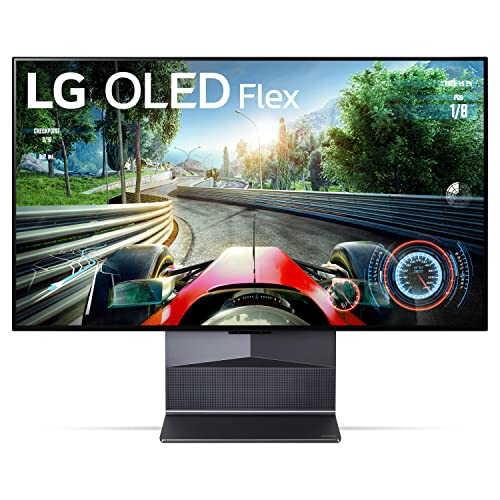
True Score
87872Experts
9313Customers
Absolutely Fresh
 $1,996.99
$1,996.99Snapshot
Reasons to Buy
- Exceptional picture quality
- Impressive brightness and contrast
- Variable Refresh Rate support
- Exceptional reflection handling
- Incredible response time
Reasons to Avoid
- Limited height adjustment and no VESA support
- Adjustable screen reverts to a flat position when off
- Risk of permanent burn-in
- Limited height adjustment and no VESA support
- The glossy display may cause reflections in bright lighting conditions
- Screen reverts to a flat position when off, which can be inconvenient
- The price may be high for some consumers
Specifications
Max Resolution 3840 x 2160 (4k) 
Backlight Type Full-Array Refresh Rate 120 Hz Display Type OLED HDMI Inputs 4 HDR Format Dolby Vision, HDR10, HLG 
LED Panel Type OLED Screen size 42″ 
Smart Platform webOS 
Sync Technology AMD FreeSync, G-Sync 
VRR Yes All Specs
Test Results
SDR Brightness (nits) 374 HDR Brightness (nits) 738 Color Gamut % (DCI P3 xy) 97.92 Response Time (ms) 2.5 Contrast Ratio (x:1) 0 EOTF (600 nit delta) 0.0028 Color Gamut % (DCI P3 uv) 99.19 Color Gamut % (Rec 2020 xy) 71.3 Color Gamut % (Rec 2020 uv) 74.64 Color Gamut % (sRGB) 0 Color Gamut % (Rec 709) 0 Color Gamut % (BT.2020) 0 Color Gamut % (Adobe RGB) 0 Color Gamut % (BT.709) 0 Input Lag (ms) 10 Color Washout (Degrees) 52 Color Shift (Degrees) 28 Brightness Loss (Degrees) 69 Reflections (%) 0.9 Low-Freq Extension (Hz) 113.14 Freq Response StdDev @ 70db 2.74 Freq Response StdDev @ 80db 2.83 Weighted Total Harmonic Distortion @80db 0.034 Intermodulation Distortion @80db 1.95 EOTF (1000 nit delta) 0.0024 EOTF (4000 nit delta) 0.0025 All Tests
All Retailers
- $1,996.99
Availability
In StockFree Shipping
No - $1,999.99$2,500Save $500
Availability
In StockFree Shipping
No
Our Verdict
The LG Flex OLED stands out as a unique choice for those seeking versatility in a TV that doubles as a computer monitor. Its flexible screen allows users to adjust the curvature for an immersive gaming or viewing experience, or keep it flat for productivity tasks. This adaptability makes it exceptionally suited for a diverse range of uses, from detailed content creation to engaging entertainment sessions. However, as the most expensive TV on the list, this versatility doesn’t come without a premium price.
The TV features a 97.92% DCI P3 color gamut, giving it excellent color accuracy, crucial for professional graphic design and video editing where precise color representation matters. The OLED panel ensures near perfect blacks and functionally infinite contrast, enhancing visual depth for all types of content.
With a response time of 2.5 ms, it keeps motion blur to a minimum, vital for fast-paced gaming or dynamic video playback. An input lag of 10 ms provides a responsive interface for computing tasks and gaming, aligning well with the needs of users who demand quick feedback from their display devices.
However, its brightness, with SDR at 374 nits and HDR at 738 nits, while adequate for most indoor environments, may not be sufficient for very brightly lit spaces. Similarly to the LG C3, the lower brightness might be a consideration for those planning to use it in sun-drenched rooms or near large windows.
If you value versatility above all else, the premium price that Flex commands might be no issue for you. The ability to tailor their viewing experience combined with excellent color accuracy and responsiveness positions the TV as an excellent choice for a wide array of monitor uses, from professional to recreational.

Best Overall

Runner Up

Best Value

Best Budget

Best Mid-Range

Premium Pick
LG C3 OLED TV
An affordable monitor alternative, offering compact size, exceptional color accuracy, perfect blacks, and swift response times. Ideal for both professional creative work and immersive entertainment experiences.
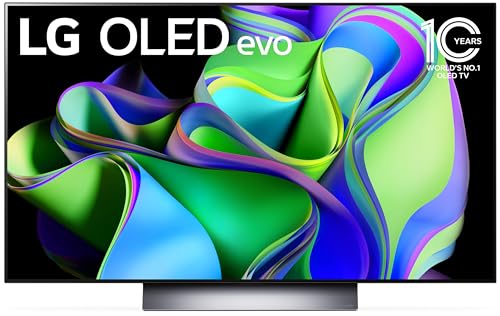
True Score
87869Experts
9310kCustomers
Absolutely Fresh
 SAVE $471$1,299.99$829.00
SAVE $471$1,299.99$829.00Snapshot
Reasons to Buy
- Excellent picture quality
- The near-infinite contrast ratio for perfect blacks
- Strong peak brightness
- High-performance motion handling
- Fast refresh rate
Reasons to Avoid
- Aggressive automatic brightness limiter
- Subpar sound quality
Specifications
Max Resolution 3840 x 2160 (4k) 
Backlight Type No Refresh Rate 120 Hz Display Type OLED HDMI Inputs 4 
HDMI Type HDMI 2.1 HDR Format Dolby Vision, HDR10, HLG 
HomeKit Compatible Yes 
LED Panel Type WOLED 
Number of Audio Channels 7.1.2 
Panel Type – Screen size 42″, 48″, 55″, 65″, 75″, 83″ 
Smart Platform webOS 
Speaker Output 20 Watts 
Sync Technology AMD FreeSync Premium, G-Sync 
VRR Yes All Specs
Test Results
SDR Brightness (nits) 383 HDR Brightness (nits) 795 Color Gamut % (DCI P3 xy) 98.98 Response Time (ms) 2.3 Contrast Ratio (x:1) 0 EOTF (600 nit delta) 0.0056 Color Gamut % (DCI P3 uv) 99.51 Color Gamut % (Rec 2020 xy) 73.28 Color Gamut % (Rec 2020 uv) 76.01 Color Gamut % (sRGB) 0 Color Gamut % (Rec 709) 0 Color Gamut % (BT.2020) 74.7 Color Gamut % (Adobe RGB) 0 Color Gamut % (BT.709) 0 Input Lag (ms) 9.6 Color Washout (Degrees) 63 Color Shift (Degrees) 34 Brightness Loss (Degrees) 70 Reflections (%) 1.1 Low-Freq Extension (Hz) 80 Freq Response StdDev @ 70db 1.14 Freq Response StdDev @ 80db 1.98 Weighted Total Harmonic Distortion @80db 0.085 Intermodulation Distortion @80db 4.49 EOTF (1000 nit delta) 0.0054 EOTF (4000 nit delta) 0.0051 All Tests
All Retailers
- $829.00$1,300Save $471
Availability
In StockFree Shipping
No - $876.95$1,197Save $320
Availability
In StockFree Shipping
No - $896.99$1,297Save $400
Availability
In StockFree Shipping
- $897.99$900Save $2
Availability
Free Shipping
No
Our Verdict
If you’re considering a TV as a computer monitor, the LG C3 is an excellent value, offering the infinite contrast and deep blacks of OLED panels in a just-right sized – and priced – 42” package. Its 98.98% DCI P3 color gamut ensures that colors are not just vibrant but incredibly accurate, a key factor for graphic design and video editing.
The C3’s responsiveness is also noteworthy, with a response time of 2.3 ms, ensuring that motion blur is virtually nonexistent. This makes the TV a solid option for fast-paced video content or gaming, and it can pull double-duty if you want to watch sports. Additionally, the input lag of 9.6 ms is low enough to support responsive computing and gaming experiences, making it suitable for both work and play.
However, its brightness levels, with SDR at 383 nits and HDR at 795 nits, limit its use in very brightly lit environments. It’s not unusable in brighter rooms, especially since its reflectivity is just 1.1% light reflected, but it’s not going to cut it in rooms that have tons of direct sunlight.
Overall, the LG C3 OLED TV combines the essential qualities of a great monitor—color accuracy, responsiveness, size and contrast—in a package that’s more affordable than other OLED options. Its limitations in brightness are balanced by its performance in other critical areas, making it a compelling choice for users looking for an immersive and responsive display for both professional and entertainment purposes.

Best Overall

Runner Up

Best Value

Best Budget

Best Mid-Range

Premium Pick
TCL QM8/QM850G QLED TV
Best For Bright Room
Best value with high brightness at the lowest price. Suitable for less intensive tasks and bright environments.
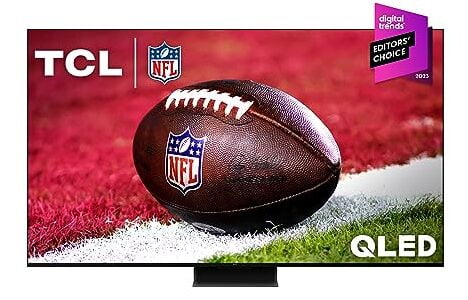
True Score
84847Experts
90478Customers
Absolutely Fresh
 SAVE $1$1,499.99$299.99
SAVE $1$1,499.99$299.99Snapshot
Reasons to Buy
- Outstanding picture quality
- Spectacular brightness and contrast ratio
- Rapid response time
- Super low input lag
Reasons to Avoid
- Disappointing viewing angles
Specifications
Max Resolution 3840 x 2160 (4k) 
Backlight Type Full-Array Refresh Rate 120 Hz 
Depth 11.7″ Display Type QLED HDMI Inputs (Total) 2 
HDMI Type HDMI 2.1 HDR Format Dolby Vision, HDR10, HDR10+, HLG 
Height 34.1″ High Dynamic Range (HDR) Yes 
Number of Audio Channels 3 
Panel Type LED Screen size 65″, 75″, 85″, 98″ 
Smart Platform Google TV 
Speaker Output 40 Watts 
Sync Technology AMD FreeSync Premium Pro 
VRR Yes 
Voice Assistant Google Assistant 
Weight 54.7 lbs 
Width 56.9″ 
Works With Amazon Alexa, Apple HomeKit, Google Assistant All Specs
Test Results
SDR Brightness (nits) 2,076 HDR Brightness (nits) 2,005 Color Gamut % (DCI P3 xy) 94.59 Response Time (ms) 8.9 Contrast Ratio (x:1) 114,057 EOTF (600 nit delta) 0.037 Color Gamut % (DCI P3 uv) 97.31 Color Gamut % (Rec 2020 xy) 75.81 Color Gamut % (Rec 2020 uv) 80.57 Color Gamut % (sRGB) 0 Color Gamut % (Rec 709) 0 Color Gamut % (BT.2020) 0 Color Gamut % (Adobe RGB) 0 Color Gamut % (BT.709) 0 Input Lag (ms) 14.3 Color Washout (Degrees) 24 Color Shift (Degrees) 31 Brightness Loss (Degrees) 32 Reflections (%) 1.8 Low-Freq Extension (Hz) 89.8 Freq Response StdDev @ 70db 4.74 Freq Response StdDev @ 80db 4.67 Weighted Total Harmonic Distortion @80db 0.128 Intermodulation Distortion @80db 8.67 EOTF (1000 nit delta) 0.0238 EOTF (4000 nit delta) 0.0271 All Tests
All Retailers
- $299.99$1,500Save $1
Availability
In StockFree Shipping
No - $1,198.00$1,398Save $200
Availability
In StockFree Shipping
Yes - $2,056.27
Availability
In StockFree Shipping
Yes
Our Verdict
The TCL QM8/QM850G QLED TV combines high brightness levels characteristic of QLED technology with the lowest price point on the list, earning it the title of Best Value TV. Its input lag of 14.3 ms and response time of 8.9 ms place it dead last in performance, but it’s still a worthy choice that comes in well under our minimum qualifying criteria, especially for anyone looking to perform less intensive tasks.
Where the set (literally) shines is in terms of brightness, with SDR and HDR brightness reaching 2076 and 2005 nits, respectively. The best-in-class SDR and second-best HDR brightness ensures visibility and vibrancy even in well-lit environments, which is essential for a monitor used in diverse settings.
While the TCL QM8’s color gamut at 94.59% DCI P3 xy isn’t the highest on our list, it still offers a wide range of colors that can accurately represent most content, whether for work or play. Coupled with QLED’s inherent resistance to burn-in and its affordability, the TCL QM8 positions itself as a competitive budget pick. It even beats out QN95B when it comes to EOTF (0.0438 vs 0.037) despite costing less than half.
The balance of performance, particularly in terms of brightness and color reproduction, alongside value pricing is what makes the TCL M8 an effective, large-screen solution for a variety of tasks without a hefty investment. It’s capable of providing a responsive and fluid experience when gaming or watching sports and it competes extremely well in any situation that puts it into a brightly lit room, on top of being a solid choice as a monitor.

Our Approach to Testing Best TV Monitors

Evan Shepard/Gadget Review
When selecting the best TV to use as a monitor, focus on low input lag and response time and a minimum resolution of 1080p for crisp, clear images. Look for 4:4:4 chroma to ensure color accuracy and a TV that covers at least 97% of the DCI P3 color gamut for vivid, true-to-life colors. Our picks, rigorously tested, deliver a seamless experience for using your TV as a computer monitor.
We gather data so you don’t have to. Our team averages testing results to accurately represent each product’s capabilities. Then, we filter and sort our buying guides to ensure products meet your needs, like those for TVs monitors with LED panels. This guarantees you’re buying the correct product.
You may notice some of our graphs contain “Source: RTings”. This is to indicate that the data we’re showing off in a graph has come from a single source – because it’s the only source that actually tested the criteria and had data for it! Normally, our data is an average out of all of the various publications that test and provide data to give you a good idea of how a product is going to perform on average.
Which Criteria Matters for Testing Best TV Monitors?
By focusing on these criteria (2 required, 4 nice to have), anyone can quickly and easily compare these TVs and how they’ll perform. This helps you make an informed decision and purchase a TV that will fit into your space.
| CRITERIA | RANGE | REQUIRED | DEFINITION |
|---|---|---|---|
| Response Time | <=10ms | Yes | Time required for a pixel to transition from one color to another and then return to its original color. |
| Input Lag | <=20ms | Yes | The time it takes for a display to change the on-screen image in response to user input. |
| Color Gamut (DCI P3 xy) | >= 97% | No (nice to have) | Evaluate the extent to which a TV can reproduce a specified spectrum of colors. |
| SDR Brightness | 300+ nits | No (nice to have) | Assess the luminance of your display when operating in Standard Dynamic Range (SDR) mode. |
| HDR Brightness | 700+ nits | No (nice to have) | Determine the luminance of your display in High Dynamic Range (HDR) mode. |
| Contrast Ratio | >= 10,000 | No (nice to have) | The ratio between the brightest white and darkest black that the screen can display. |
Our Trusted Data Sources
(Publication category Score is 80%+)
We looked at 210+ TV reviewers and while 24 are trustworthy (60%+ Trust Rating), we only use data from the testers that are “very trusted” which means a Trust Rating above 70%. The three we have listed below are our most trusted for TVs, along with our own in-house TV expert.
- Evan Shepard – Gadget Review
- Matthew Lopes – RTings, MuckRack
- Will Greenwald – PCMag, MuckRack, Twitter
- David Katzmaier – CNET, MuckRack, Twitter
Interested in a comprehensive analysis of our data sources? We’ve got you covered. Below, you’ll find a detailed list of every TV review website we’ve identified, organized by their respective Trust Ratings from highest to lowest. But we didn’t stop there. We’ve meticulously reviewed each publication and verified the data by checking whether the authors have bio links to MuckRack or LinkedIn. We’re committed to not only checking the facts but ensuring their veracity.
TV Test Data & Results
1. SDR & HDR Brightness TV Test Results
If you’re considering using your TV as a computer monitor, keep in mind that in well-lit rooms, the brightness level of your TV monitor, quantified in nits, is key to a great viewing experience. A TV that doesn’t meet the brightness requirement will struggle against natural and artificial light, resulting in a dim, lackluster image. Essentially, nits measure how well your TV can stand up to light interference, with higher values ensuring a sharper, more vivid display.
For standard viewing on the best TV monitor, you should look for at least 300 nits to strike the right balance between clarity and color quality in standard dynamic range (SDR) content. For high dynamic range (HDR) content, which offers richer colors and greater contrast, a minimum of 700 nits is ideal to truly appreciate the enhanced visuals. These brightness levels are recommended to ensure your TV performs well in bright settings, allowing you to enjoy your shows and movies without any loss in detail or quality. Aim for these minimums: SDR Brightness >= 300 nits; HDR Brightness >= 700 nits for the optimal experience.
Discover the top TV monitors, ranked from brightest to least, all exceeding our brightness criteria.
Brightness
SDR: 300+ nits
HDR: 700+ nits
Acceptable range of performance
Definition: Maximum brightness in a specified pattern size window. Most commonly measured in a 10% or 100% white window.
Units of Measurement: nits (alternatively cd/m²)
Tools to Measure: TV, luminance meter
Why It’s Important:
Brightness helps counter ambient light so that details and colors don’t wash out and get lost.
SDR Brightness (in nits, higher is better)
HDR Brightness (in nits, higher is better)
2. Color Gamut (DCI P3 xy) TV Test Results
Color Gamut
>= 97%
Acceptable range of performance
Definition: The TV’s capability to display a spectrum of colors.
Units of Measurement: % (color space coverage in percent)
Tools to Measure: Colorimeter
Why It’s Important:
Inaccurate colors compromise the authenticity of the content.
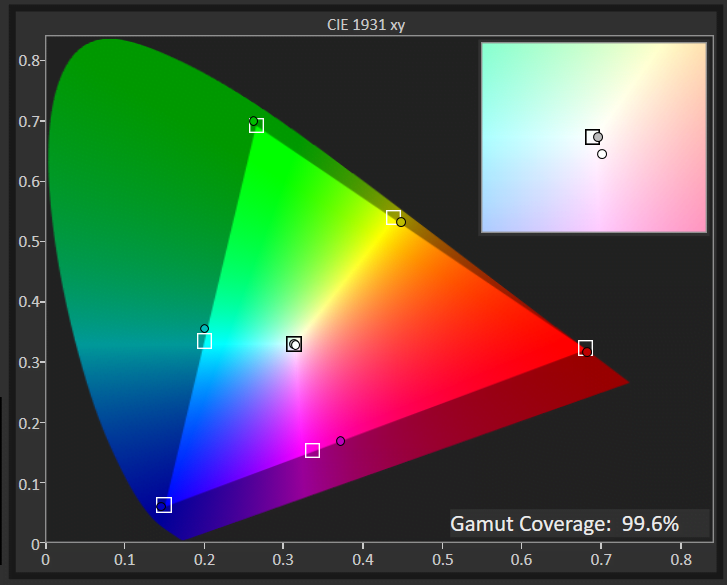
Color gamut defines the range of colors a TV monitor can reproduce, directly affecting how vibrant and true-to-life the images look. A wide color gamut in a compact TV brings out richer, more vivid colors – from the lush greens of a garden to the bright colors of animated characters, enhancing your viewing experience to closely mimic real life.
This concept is technically measured against standards like the DCI P3 xy, a benchmark for high-quality visuals. A TV monitor covering a higher percentage of this color space can display colors more accurately and vividly.
For those who prioritize vibrant and immersive visuals in a smaller package, aiming for a TV monitor with a color gamut of 97% or higher on the DCI P3 xy scale is ideal. This ensures that the content you watch is as vibrant and lifelike as possible. If you want to still consider a smaller computer monitor alongside a TV monitor, consider reading our guide to the best 24-inch monitor, where compact size meets exceptional color performance.
Below are the top TV monitors, ordered by color gamut.
DCI P3 XY Color Gamut (as a %; high is better)
3. Input Lag Time Test Results
Input Lag
< 20ms
Acceptable range of performance
Definition: Input lag gauges the time delay between an input action, like pressing a button, and the resulting on-screen reaction.
Units of Measurement: milliseconds (ms)
Tools to Measure: Screen, camera, test software
Why It’s Important:
A higher input lag can hinder your timing and the TV’s performance so aim for a TV with little to no input lag.
Just as a slow response time binds you with invisible shackles, high input lag is like wading through quicksand, pulling you down when speed is of the essence. Imagine you’re facing an enemy in a duel; you press the button to leap or strike, but there’s a delay. Your character stumbles a moment too late, and the opportunity slips through your fingers. It’s not just about delayed reactions; it’s about being desynchronized from the game’s rhythm, turning your split-second decisions into missed chances.
What exactly is input lag? It’s the time it takes for your game console’s signal to translate into action on your screen. Ideally, for gaming, you’d want an input lag of 20ms or less to stay in perfect sync with the game. At these low latencies, your actions are immediate, your commands precise, and your timing impeccable. With minimal input lag, when you command it, it happens – instantly.
Below are the top TV monitors, ordered by input lag, all exceeding our testing criteria.
Input Lag (in milliseconds; lower is better)
4. Response Time TV Test Results
Response Time
1ms-10ms
Acceptable range of performance
Definition: Speed at which a pixel transitions from one color to another
Units of Measurement: milliseconds (ms)
Tools to Measure: Screen, camera, test software
Why It’s Important:
A faster response time means less blur and thus more accuracy
A slow response time on a TV monitor during fast-paced scenes is like trying to watch a thrilling movie with a foggy lens. Imagine settling in for an action-packed sequence, only to have the swift movements turn into a blur, robbing you of the crisp, clear detail you crave. This isn’t just a minor annoyance; it’s a major detriment to your viewing experience, leaving you with a picture marred by motion blur and visual artifacts.
So, what exactly is response time? It measures how quickly a pixel on your TV can change from one color to another. In the context of watching fast-moving content or enjoying dynamic scenes on a TV monitor, a low response time is crucial. A response time of 15 ms or lower is good, but if you plan on gaming on this set, aim for a response time of 10 ms or lower. At these levels, your TV monitor ensures smooth transitions and sharp visuals, making every scene come to life without any distracting blurs or delays. Consider checking out our best LG TV guide, as LG is known for models with excellent response times that cater to action-packed movies and sports.
Gamers should also consider exploring our guide to the best gaming TV, which are designed with low response times and high refresh rates to enhance your gaming experience. Additionally, for tips on minimizing input lag further, our guide on how to fix input lag on a TV offers solutions to optimize your setup for even smoother gameplay.
Below are the top TV monitors, ordered by response time, all exceeding our testing criteria.
Response Time (in milliseconds; lower is better)
5. Contrast Ratio Test Results
For TV monitor enthusiasts, a solid contrast ratio is crucial for enjoying your favorite TV shows or movies, especially in darker settings. This feature directly impacts how lifelike and dynamic the picture appears on your screen, ensuring that dark scenes are displayed with clear, crisp blacks instead of murky grays and bright scenes retain their detail without appearing washed out.
Put simply, the contrast ratio is all about the range of luminance a TV can produce, from the deepest blacks to the brightest whites. It’s what brings depth to the image, enhancing the realism of every scene. Watching a movie in the dark, for example, the difference between a TV with a poor contrast ratio and one with a high ratio is stark: the former struggles, blending shadows into a flat gray, while the latter delivers true black, making night scenes more immersive and detailed.
Ideally, a contrast ratio of 10,000:1 is what you should aim for in a TV monitor. This level of luminance variance ensures that you’re getting a picture quality that can handle the nuances of lighting in any scene, providing a viewing experience that’s both rich and engaging. If you prioritize a high contrast ratio for a lifelike and dynamic picture, especially in darker settings, the best 1440p monitor can be an excellent choice that tends to be cheaper than 4K monitors but has a higher resolution that the top 1080p gaming monitors.
Note: OLED TVs have infinite contrast ratio, indicated by “0.”
Below are the top TV monitors, ordered by contrast ratio, all exceeding our testing criteria.
Contrast Ratio
>=10,000:1
Acceptable range of performance
Definition: Difference between the darkest black and the brightest white a screen can display.
Units of Measurement: cd/m2
Tools to Measure: Luminance meter
Why It’s Important:
A higher contrast ratio delivers deeper blacks, enhancing content definition, especially in darker rooms.
Contrast Ratio (higher is better)
Best TV Monitors: Mistakes To Avoid
- Ignoring Size Considerations: Not considering the appropriate size for the viewing distance and intended use, which can result in discomfort or poor viewing experience. For more compact spaces or closer viewing distances, options like the best 24-inch TV models can provide an optimal balance between size and quality. And if you’re going to be bringing this TV monitor on the go constantly, the best portable TV can adapt to different environments without sacrificing quality.
- Overlooking Display Specifications: Failing to research and understand key display specifications such as TV resolution, refresh rate, and panel type, which can lead to subpar image quality. Refresh rate is measured in Hertz (Hz) in case you’ve wondered what Hz is on a TV. While related, the refresh rate (Hz) on TVs indicates how often the image refreshes per second for smoother motion, whereas response time measures how quickly a pixel can change color, affecting clarity during fast action scenes.
- Neglecting Connectivity Options: Not checking for the necessary ports and connectivity options needed for external devices such as gaming consoles like the PS5, streaming devices, or computers. For gamers, this is critical, so ensure your TV monitor or top-rated gaming monitor is compatible with your devices. Additionally, understanding how to connect a soundbar to your system can elevate your gaming and entertainment experience, offering richer, more immersive audio to accompany your visuals.
- Disregarding User Reviews: Not consulting user reviews or professional recommendations, which can result in purchasing a monitor with known issues or shortcomings. For example, as a gamer, exploring reviews for top gaming TVs, known for their fast refresh rates and minimal input lag to boost your gaming experience, can help confirm the TVs meet your needs.
The TV Monitor Tests Compared
Product |
True Score
|
SDR Brightness
|
HDR Barightness
|
Color Gamut
|
EOTF
|
Response Time
|
Contrast Ratio
| |
|---|---|---|---|---|---|---|---|---|
| 91 |
|
|
|
|
|
| $989.00 $1,500 $511 |
| 87 |
|
|
|
|
|
| $1,996.99 |
| 87 |
|
|
|
|
|
| $829.00 $1,300 $471 |
| 84 |
|
|
|
|
|
| $299.99 $1,500 $1 |

